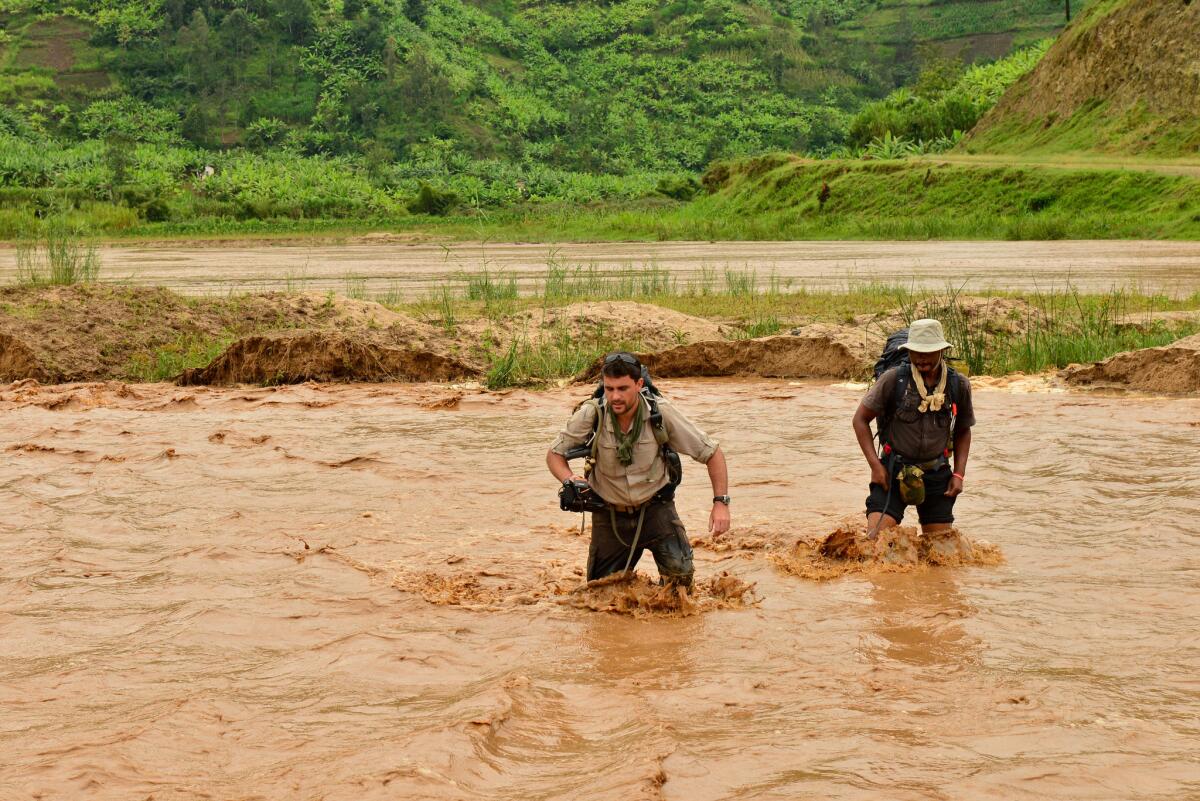Review: In the age of Google Maps, why walk the 4,000 mile Nile River? Levison Wood’s book explains

An image of Levison Wood crossing the Nyabarongo River, which cuts a swathe through Rwanda. From the book “Walking The Nile,” by Levison Wood.
The Nile, from its disputed source, runs for as many as 4,000 miles. In recorded history, no man has ever walked its full course — and in April 2014 former British paratrooper Levison Wood set out to do just that.
“To some, the very idea seems archaic,” Wood writes of his journey, “and, in a world of Google Maps, where every valley and hillside has already been plotted, the traditional age of exploration is certainly gone. But exploration has always been about more than pure discovery or of being the first to do something.”
So what is it about a journey on foot? Humans walk; our ability to stand and move on hind legs is one of the ways we distinguish ourselves from other species. Walking allowed us to roam far and wide, and yet it’s an activity most of us do without thinking, for the simplest of tasks, like going to the refrigerator for ice cream.
Wood isn’t interested in a kitchen. In the opening scene, he’s in a busted-up room at the South Sudan hotel, in the capital of Juba as a battle rages. He’s walked here — 1,000 miles from the south, and he intends to head an additional 3,000 miles, to the northern edge of Egypt. A more normal sort have encountered the outbreak of war and quit.
Yet in just such a moment — with bullets cracking and death apparently imminent — Wood is an unflappable if not eloquent guide. During a lull in the fighting, he runs for food. “We ate at a small Ethiopian restaurant,” he writes dryly, “but we didn’t stay long. The looks we got from fellow diners — all armed to the teeth — were enough to drive us back to the relative safety of the hotel.” “Welcome to South Sudan,” an official had told him, “with a smile that spoke of a thousand things.”
It’s not just people who are dangerous. In Uganda, “the mangrove forests were so alive with fire ants and spiders that we were forced to wade out into the lake and skip around the swamp instead.” Later, contemplating a swim just beyond the South Sudanese fishing village of Terekeka, Wood listens as one of the Mundari tribesmen — who has just taught Wood how to wrestle and to cover his body with ash to discourage mosquitoes — tells the Englishman that entering the river here is simply too dangerous. “They are monsters,” the man says, gesturing at beasts lurking out of sight. “My brother was eaten by a crocodile,” he continues. “At eleven o’clock this morning.”
Wood is often just as frank about terrain that is as endless as it is unyielding, with surprises and pitfalls that are as brutal as they are random.
Haunting this book is the traumatic situation of Matthew Power, an American journalist (a distant acquaintance of this reviewer) and experienced outdoorsman who perished of apparent heatstroke while on assignment for a men’s magazine to walk alongside Wood.
“Together we lurched across the plain,” Wood writes of Power’s final hours, “finally entering the relative cool beneath the branches. But we had barely shed the sun when I… saw Matt face down in the dirt. By the time I reached him, he was trying to pick himself up, only to crumble again. He looked at me, his eyes open wide, with something approaching bewilderment on his face…. he had come to some moment of epiphany, a simple, chilling realization. ‘Oh my God,’ he uttered, and I wish I could say it was in disbelief, ‘I’m going to die.’”
“[T]here were no longer any words coming from his lips,” he continues. “Now he only made odd, whimpering noises — noises that will remain with me through all of my years ….Because of my expedition, he would never see home again.”
It’s gripping stuff, shattering, almost, and real credit is due I think to Wood that the scene is captured so fully.
But why do men — and books like these are usually about men — press themselves into such situations? Why did Matthew Power die so needlessly? Shouldn’t Wood have quit immediately?
As if in answer to these questions, not long after Power’s death, Wood encounters a riverside refugee camp, where in a sea of tents there’s a barber, tables set up for a tea shop, and an area women can have their hair braided. “Life goes on,” says a porter, who is paid money to make Wood’s walk possible.
“The Nile, we were seeing, brings life — but it also takes it away,” Wood writes. And yet: “I was determined to follow the river, no matter what.”
There remain certain dilemmas of being a white man walking through Africa. Wood is fully aware of this, and “Walking the Nile” is littered with reflections about the monsters who’ve come before him: John Hanning Speke, Dr. Richard Kandt and various other Victorian-age explorers, who not only paid but also shot their ways through difficult terrain.
If Wood defiles this terrain, he does so by not describing it as vibrantly as you might hope.
You can’t have it all. Wood aims for an accumulation of specific and grounded experiences, not some smear of images half-seen from a car window. It’s not an abstraction in Rwanda, for instance, when Wood walks among people who two decades earlier were locked in a bloody civil war. He stops at a prison. “Walls had crumbled, long grasses had grown up. Piece by piece, the stone was returning to the earth. Another twenty years, I thought, and it would be gone, not even the bullet holes in the walls to remind us what had happened here.”
Maybe the simplest task we can expect of those who write books about walking is that they see and share what we might otherwise never have seen, or may soon lose forever. In this, Wood succeeds.
And he has some encounters worth savoring. North of Khartoum, at one dusty little shanty, a shopkeeper “within ten minutes” offers Wood land, to build him a house, and to find him a wife. Another threatens to divorce his wife if the travelers don’t stay for lunch.
Collecting these stories — let alone doing so beautifully — requires a variety of lucky skills. Wood emerges as a dutiful and brave guide, but one who might have been more poetic or speculative in his prose.
Never as delightful as Bill Bryson or as dazzling as Geoff Dyer, missing the higher powers of observation or self-awareness found in the works of Helen Macdonald and Gretel Ehrlich, Wood has more in keeping with the sober writing of Rory Stewart, who later became a parliamentarian.
The great mountain climber George Mallory — whom Wood of course quotes — said one summits Everest “because it’s there.” Wood and long walkers of his ilk do something similar if less grand: Out of a kind of age-old honor, they invent a task and risk a great deal and aim to finish what they have started, so they can tell us what happened.
“It was real sadness that was touching me now,” Wood concludes in the final pages. “There was nowhere left to walk.”
Deuel is the author of “Friday Was the Bomb: Five Years in the Middle East.” He teaches writing at UCLA and Mount St. Mary’s University.
::
Walking the Nile
Levison Wood
Atlantic Monthly Press: 352 pp., $26
More to Read
Sign up for our Book Club newsletter
Get the latest news, events and more from the Los Angeles Times Book Club, and help us get L.A. reading and talking.
You may occasionally receive promotional content from the Los Angeles Times.







